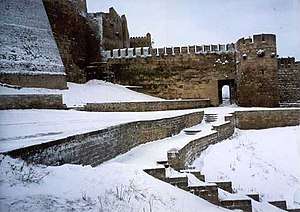Tong Yabghu Qaghan
Tong Yabghu Qaghan (r. 618–628 or 630[1]) (also known as T'ung Yabghu, Ton Yabghu, Tong Yabghu Khagan, Tun Yabghu, and Tong Yabğu, Traditional Chinese 統葉護可汗, Simplified Chinese: 统叶护可汗, pinyin Tǒngyèhù Kěhán, Wade-Giles: t'ung-yeh-hu k'o-han) was khagan of the Western Turkic Khaganate from 618 to 628 AD. His name is usually translated as "Tiger Yabgu" in Old Turkic.[2] Another interpretation of his name is "sufficiency" or "completeness".[3] He was the brother of Sheguy (r. 611–618), the previous khagan of the western Göktürks, and was a member of the Ashina clan.[4] Tong Yabghu's reign is generally regarded as the zenith of the Western Göktürk Khaganate.[5] His clan was syncretized Buddhist and native folk religion.
| Tong Yabghu Qaghan 統葉護可汗 | |
|---|---|
| Fourth Qaghan of the Western Turkic Khaganate | |
| Reign | 618-628 |
| Predecessor | Sheguy |
| Successor | Baghatur Qaghan |
| Died | 628 |
| House | Ashina |
| Father | Tulu Tegin (都六) |
Reign

Tong Yabghu maintained close relations with the Tang Dynasty of China, and may have married into the Imperial family.[6] The Chinese Buddhist pilgrim Xuanzang visited the western Göktürk capital Suyab in modern Kyrgyzstan and left a description of the khagan. Scholars believe the khagan described by Xuanzang was Tong Yabghu.[7] Gao and La Vaissière argue that the khagan Xuanzang met was his son Si Yabghu, rather than Tong Yabghu.[8][9] Xuanzang described the khagan as follows:
The khan wore a green satin robe; his hair, which was ten feet long, was free. A band of white silk wound round his forehead and hung down behind. The ministers of the presence,[10] numbering two hundred in number, all wearing embroidered robes, stood on his right and left. The rest of his military retinue [was] clothed in fur, serge and fine wool, the spears and standards and bows in order, and the riders of camels and horses stretched far out of [sight].[11]
According to the Old Book of Tang, Tong Yabghu's reign was once considered as the golden age of Western Göktürk Khaganate:
Tong Yehu Kaghan is a man of bravery and astuteness. He is good at art of war. Thus he controlled Tiele tribes to the north, confronted Persia to the west, connected with Kasmira (nowadays Kashmir) to the south. All countries are subjected to him. He controlled ten thousands of men with arrow and bow, establishing his power over the western region. He occupied the land of Wusun and moved his tent to Qianquan north of Tashkent. All of the princes of western region assumed the Turk office of Jielifa. Tong Yehu Kaghan also sent a Tutun to monitor them for imposition. The power of Western Turks had never reached such a state before".[12]
Campaigns against Persia

Tong Yabghu's empire fought with the Sassanids of Iran. In the early 620's the khagan's nephew Böri Shad led a series of raids across the Caucasus Mountains into Persian territory. Many scholars have identified Tong Yabghu as the Ziebel mentioned in Byzantine sources as having (as khagan of the Khazars) campaigned with the Emperor Heraclius in the Caucasus against the Sassanid Persian Empire in 627–628.[13] It has long been maintained by some scholars, including Chavannes, Uchida, Gao and Xue Zhongzeng that Tong Yabghu cannot be positively identified with Ziebel (or any Khazar ruler) and may actually have died as early as 626. These scholars point to discrepancies in the dates between Byzantine and Chinese sources and argue that definitively conflating Ziebel with Tong Yabghu is an exaggeration of the extant evidence.[8][14] The latest research on this topic proves that they were right: if Tong indeed died in 628, Ziebel is to be identified with Sipi khagan, Tong Yabghu's uncle, who murdered him and rose briefly to the throne.[15] Sipi was by then pronounced Zibil and he was a small khagan in charge of the western part of Tong Yabghu's empire, exactly as Ziebel was according to the Byzantine sources. Ziebel is described as the brother of Tong in the Byzantine sources, and as his uncle in the Chinese sources, a discrepancy which long precluded the identification. However uncle and elder brother is the same word in ancient Turkish, äçi, and the Chinese sources could not render this double meaning with their very precise system of kinship names.[16]

Governance
Tong Yabghu appointed governors or tuduns to manage the various tribes and people under his overlordship.[7] In all likelihood Tong Yabghu's nephew Böri Shad, and son of Zibil/Ziebel was the commander of the Khazars, the westernmost of the tribes owing allegiance to the Western Göktürks; this branch of the family may have provided the Khazars with their first khagans in the mid seventh century.[17]
Death
In ca. 630 he was murdered by Külüg Sibir, his uncle and a partisan of the Dulu faction. Following the death of Tong Yabghu, the might of the Western Göktürks largely collapsed. Although the khaganate lingered for a few decades before falling to the Chinese Empire, many of the client tribes became independent and a number of successor states, including the Khazar Khaganate and Great Bulgaria, became independent.[18]
Notes
- 628 from Zizhi Tongjian, vol. 193. 630 in Baumer,2,198, Christian, p260, Sinor,309 has alive in 630. Baumer starts the reign c617.
- Golden, Khazar Studies passim; Brook ch. 1;
- Xue 284
- Christian 260
- Golden, Nomads 30.
- Golden, Introduction 135. According to Chinese historical sources, the marriage was never carried out because of interference by the Eastern Göktürk Illig Qaghan, whose territory sat between his territory and Tang territory and who felt threatened by the proposed marriage. Zizhi Tongjian, vol. 192.
- Christian 260.
- Gao 113.
- La Vaissière 2010. If 630 is correct for Xuanzang the son business must be related to the 628 death date.
- "ta-Kuan"", probably tarkhan is intended; see Christian 260.
- Adapted from Watters I:74,77.
- Ying, Lin. Western Turks and Byzantine gold coins found in China - Transoxiana
- The campaign is described in detail in the Chronicle of Theophanes Confessor. The identification of Ziebel as "Khagan of the Khazars" rather than of the Western Turks is likely because the Khazars, as Göktürk vassals, made up the largest contingent of the Göktürk army with whom the Greeks had contact. Klyashtorny 96–97; Golden, Introduction 135; Christian 260.
- E.g., Xue 286–289.
- La Vaissière 2013.
- La Vaissière 2010b
- Christian 283; Artamanov 170–180.
- E.g., Christian 260–285.
References
- Artamonov, Mikhail. Istoriya Khazar. Leningrad, 1962.
- Brook, Kevin Alan. The Jews of Khazaria. 2nd ed. Rowman & Littlefield Publishers, Inc, 2006.
- Christian, David. A History of Russia, Mongolia and Central Asia. Blackwell, 1999.
- Gao Lei. "Revision of Zhongguo Lishi Da Cidian's Sui Tang Wudai Juan (Comprehensive Dictionary of Chinese History, vol. Sui, Tang and Five Dynasties)". Journal of Yantai Normal Institute's Philosophy & Social Sciences, 2001.
- Gibbon, Edward. The History of the Decline and Fall of the Roman Empire. London, 1845.
- Golden, Peter Benjamin. Introduction to the History of the Turkic Peoples. Wiesbaden: Harrasowitz, 1992.
- Golden, Peter Benjamin. Khazar Studies: An Historio-Philological Inquiry into the Origins of the Khazars. Budapest: Akademia Kiado, 1980.
- Golden, Peter Benjamin. Nomads and Sedentary Societies in Medieval Eurasia. Washington, D.C.: American Historical Society, 1998.
- Klyashtorny, S.G. and T.I. Sultanov. Kazakhstan. Alma-Ata, 1992.
- La Vaissière, E. de "Notes sur la chronologie de Xuanzang" Journal Asiatique 298.1 2010 pp. 157–168.
- La Vaissière, E. de "Oncles et frères : les qaghans Ashinas et le vocabulaire turc de la parenté" Turcica 42, 2010, p. 267–277
- La Vaissière, E. de "Ziebel Qaghan identified" in C. Zuckerman (ed.), Constructing the 7th century (Travaux et mémoires 17), Paris 2013, pp. 741–748
- Mango, C. & R. Scott (trans.), The Chronicle of Theophanes Confessor, Oxford University Press, 1997.
- Movses Kagankatvatsi. История агван Моисея Каганкатваци, писателя X века (trans. and ed. by Patkanov). St. Petersburg, 1861.
- Xue, Zongzheng. A History of Turks. Beijing: Chinese Social Sciences Press, 1992. ISBN 7-5004-0432-8.
| Preceded by Sheguy (She Kui) |
Khan of the Western Turkic Khaganate (one rival line) 618–628 |
Succeeded by Külüg Sibir (Ashina Moheduo) |
| Succeeded by Irbis Bolun Cabgu (Ashina Dieli) |